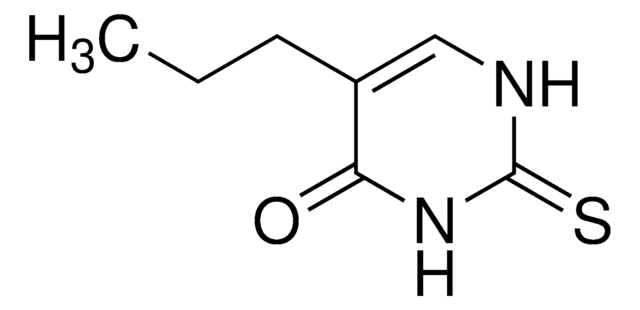P3755
6-Propyl-2-thiouracil
enzyme inhibitor
Sinonimo/i:
2,3-Dihydro-6-propyl-2-thioxo-4(1H)-pyrimidinone, 4-Hydroxy-2-mercapto-6-propylpyrimidine
About This Item
Prodotti consigliati
Descrizione
enzyme inhibitor
Saggio
≥99% (HPLC)
Forma fisica
powder
Punto di fusione
218-220 °C (lit.)
Solubilità
10% NH3: 100 mg/mL, clear to slightly hazy, colorless to faintly yellow
Stringa SMILE
CCCC1=CC(=O)NC(=S)N1
InChI
1S/C7H10N2OS/c1-2-3-5-4-6(10)9-7(11)8-5/h4H,2-3H2,1H3,(H2,8,9,10,11)
KNAHARQHSZJURB-UHFFFAOYSA-N
Informazioni sul gene
human ... DIO1(1733) , TPO(7173)
Cerchi prodotti simili? Visita Guida al confronto tra prodotti
Descrizione generale
Applicazioni
Azioni biochim/fisiol
Avvertenze
Warning
Indicazioni di pericolo
Consigli di prudenza
Classi di pericolo
Acute Tox. 4 Oral - Carc. 2
Codice della classe di stoccaggio
11 - Combustible Solids
Classe di pericolosità dell'acqua (WGK)
WGK 3
Punto d’infiammabilità (°F)
Not applicable
Punto d’infiammabilità (°C)
Not applicable
Dispositivi di protezione individuale
Eyeshields, Gloves, type P3 (EN 143) respirator cartridges
Certificati d'analisi (COA)
Cerca il Certificati d'analisi (COA) digitando il numero di lotto/batch corrispondente. I numeri di lotto o di batch sono stampati sull'etichetta dei prodotti dopo la parola ‘Lotto’ o ‘Batch’.
Possiedi già questo prodotto?
I documenti relativi ai prodotti acquistati recentemente sono disponibili nell’Archivio dei documenti.
I clienti hanno visto anche
Il team dei nostri ricercatori vanta grande esperienza in tutte le aree della ricerca quali Life Science, scienza dei materiali, sintesi chimica, cromatografia, discipline analitiche, ecc..
Contatta l'Assistenza Tecnica.












